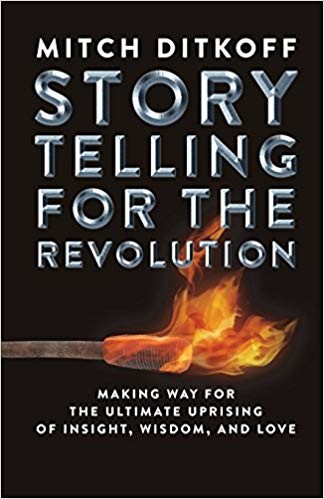Launching a Powerful Project in the World is a Team Sport

For the moment, let's say you are on the cusp of launching a bold new project in the world -- one that not only inspires you, but is the first thing you talk about whenever people ask you what you're up to these days. You know: Your life's work. Your calling. What moves you.
Congratulations! I am super happy for you, especially since all of us need meaningful projects we can throw our whole selves into. Well done! Awesome! Rock on!
That being said, there is one thing I urge you to keep in mind as your project unfolds. Innovation is a team sport.
While the origination of a powerful new idea or initiative is often an individual experience, implementing that idea requires a truckload of collaboration. Maybe two truckloads. Or three. And that, unfortunately, is where a lot of wonderful, new projects break down -- especially projects that require committed, responsible volunteers.
The reasons are many, but they fundamentally boil down to this:
1) Lack of a clear vision by the idea originator: 2) Inability to communicate that vision to others; 3) Lack of a clear strategy/game plan; 4) Relationship/control issues; 5) Lack of a clear decision-making process; 6) Unclear roles and responsibilities; 7) Funky communication (including poorly facilitated meetings).

Knowing you have precious little time to read my rant, I am going to cut to the chase and list ten key "best practices" for you to consider employing as you move forward with your beautiful, inspired, much-needed project. Ready?
1. Get super clear about your vision and be able to communicate it in 60 seconds or less.
2. Attract a core team of trusted collaborators to you -- your so-called "inner circle" who you can jam with, vent to, and get honest feedback from.
3. Do a deep dive with your core team, so you get everything on the table, i.e. WHY each person wants to participate, what skills they bring to the project, your expectations -- and theirs -- of their participation, the specific roles you are inviting people to take on, and what your team's operating agreements will be.
4. Allow your original BIG IDEA to morph, via the input of your core team and other people who will be attracted to your project. HINT: Even though YOU started it, everyone involved needs to treat it like their own. If not, they will end up feeling disengaged or disempowered.
5. Get early feedback on your idea from a diverse group of people. It is easy to get so intoxicated with our ideas that we become blind to their flaws.
6. In collaboration your core team, conjure up a Version 1.0 of a game plan -- a not-yet-cut-in-stone strategy for moving forward. This will inform your need for volunteers, funding, and resources. It will also lower your stress.
7. Define the roles and responsibilities that need to be filled by still-to-be enrolled volunteers. And, when you invite people to participate, make sure you give them a written description of the roles you are asking them to play.
8. Find ways to keep everyone, on the team, updated, informed, and acknowledged for all the efforts they are making.
9. Clear the air quickly, whenever there is a breakdown with anyone on the team.
10. Make sure your meetings are well-designed and facilitated. Always begin with some "personal check in" time and some soulful conversation about WHY this project has the potential to make a huge difference.
Launching Project Teams
Idea Champions
Posted by Mitch Ditkoff at 12:07 PM | Comments (0)
Innovation from the Inside Out
These days, almost all of Idea Champions' clients are talking about the need to establish a culture of innovation. Some, I'm happy to report, are actually doing something about it. Hallelujah! They are taking bold steps forward to turn theory into action.
The challenge for them is the same as it's always been -- to find a simple, authentic way to address the challenge from the inside out -- to water the root of the tree, not just the branches.
External systems and protocols, no matter how seductive they are to create, are simply not sufficient to guarantee real innovation. In the words of Oliver Wendell Holmes, "Systems die. Instinct remains."
This is not to say that organizations should ignore systems and structures in their effort to establish a culture of innovation. They shouldn't. But systems and structures all too often become the Holy Grail -- much in the same way that Six Sigma has become the Holy Grail.
Unfortunately, when the addiction to systems and structures rules the day, an organization's quest for a culture of innovation degenerates into nothing much more than a cult of innovation.

Organizations do not innovate. People innovate. Inspired people. Fascinated people. Creative people. Committed people. That's where innovation originates -- from deep within the inspired individual who understands that his/her sustained effort is what's required to go beyond the status quo.
The organization's role -- just like the individual manager's role -- is to get out of the way. And while this "getting out of the way" will undoubtedly include the effort to formulate supportive systems, processes, and protocols, it is important to remember that systems, processes, and protocols are never the answer. They are the context, not the content. They are the husk, not kernel. They are the menu, not the meal.
Ultimately, organizations are faced with the same challenge that religions are faced with. Religious leaders may speak passionately about the virtues their congregation needs to abide by, but sermons only name the challenge and remind people to experience something -- they don't necessarily change behavior.
Change comes from within the heart and mind of each individual. It cannot be legislated or evangelized into reality.
What's needed in organizations who aspire to innovation is an inner change. People need to experience something within themselves that will spark and sustain their effort to innovate -- and when they experience this "something," they will be self-sustaining.
They will think about their projects in the shower, in their car, and in their dreams. They will need very little "management" from the outside. Inside out will rule the day -- not outside in. Intrinsic motivation will flourish.
People will innovate not because they are told to, but because they want to. You can create all the reward systems you want. You can reinvent your work space until you're blue in the face. You can license the latest and greatest idea management tool, but unless each person in your organization OWNS the need to innovate and finds a way to tap into their own innate brilliance, all you'll end up with is a mixed bag of systems, processes, and protocols -- the husk, not the kernel -- the innovation flotsam and jetsam that the next administration or next CEO or next key stakeholder will mock, reject or change at the drop of a hat if the ROI doesn't show up in the next 20 minutes.
You want culture change? You want a culture of innovation?
Great. Then find a way to help each and every person in your organization come from the inside out. Deeply consider how you can nurture, and develop the primal need all people have to create something extraordinary.
What is the simplest thing you can do, today, to spark innovation on your team?
Posted by Mitch Ditkoff at 10:58 AM | Comments (10)
October 17, 2017Bottom Up Innovation!

If you are working with a team of any kind and are hoping for more innovation, know this: it's a function of "intrinsic motivation", not pep talks, carrots, sticks, or "new initiatives." Find out what people REALLY want to do and, assuming it is aligned with your organization's vision, give your blessings and get out the way. Will every bottom-up effort work? Of course not. But some will. Go ahead. Roll the dice. Empower people to make some magic!
Illustration: gapingvoid
Idea Champions
MitchDitkoff.com
Posted by Mitch Ditkoff at 01:06 PM | Comments (0)
October 15, 2017What Some Consultants See That Leads to Them Getting Fired Or Never Hired in the First Place

"They are playing a game.
They are playing
at not playing a game.
If I show them
I see they are,
I shall break the rules
and they will punish me.
I must play their game,
of not seeing I see the game."
-- R.D. Laing
Idea Champions
Bridging the Gulf
Listening with Impact
Becoming an Adaptive Leader
Posted by Mitch Ditkoff at 11:12 AM | Comments (0)
October 12, 2017What It Really Means to Be a Chief Innovation Officer

Some sound advice here, from the Harvard Business Review, on what it takes to be a successful Chief Innovation Officer.
Idea Champions
A workshop for innovation leaders
The Current Reality Check Up
Posted by Mitch Ditkoff at 10:35 PM | Comments (0)
October 11, 2017The NBA's new MVP

And that would be... drum roll please... Mike Kennedy -- the NBA's Associate Vice President of Talent and Learning.
Read more about Mike's leading edge work here, as well as the NBA's renewed commitment, under Commissioner, Adam Silver, to be a robust, learning organization that is as much "on their game" off the court, as they are on.
And just in case you're assuming the article in Chief Learning Officer is some kind of puff piece, it's not. As one of the 40 vendors Mike has brought in to deliver workshops to the NBA's rising leaders, I know, from first-hand experience that Mike is the real deal: super-smart, creative, committed, authentic, funny, and a true team player. I'm not sure if Mike can dunk, but he's definitely got game.
ME AS A 17-YEAR OLD HIGH SCHOOL POINT GUARD

My other clients
What my clients say
Mike chose one of Idea Champions' workshops to bring to the NBA
Posted by Mitch Ditkoff at 06:14 PM | Comments (0)














